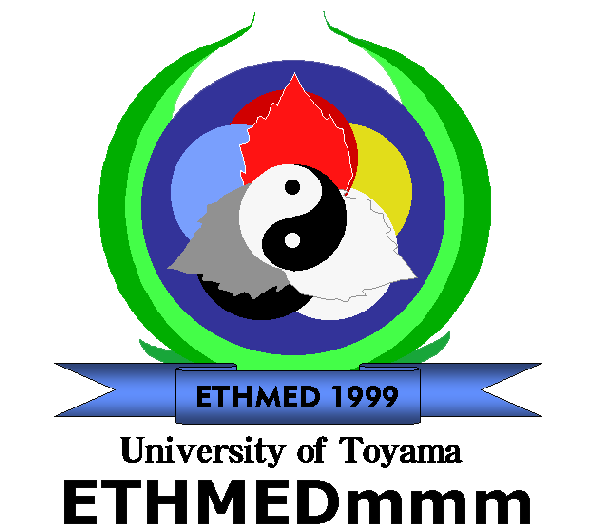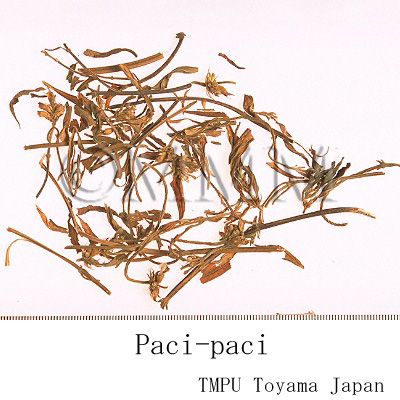Crude drug sample data base
※Click on the image to enlarge it.
Scientific information data base
| Crude drug name | Indonesian name, English name | Lenglengan | ||
|---|---|---|---|---|
| crude drug image |
| |||
| Original plant name | Leucas lavandulifolia Sm. | |||
| Family name | Labiatae | |||
| Used part | Aerial part | |||
| Distribution area | It is distributed from India, Mascarenes to China, throughout Malaysia. In Java it grows as a weed on sunny dry localities, along roadsides, from lowland up to 1500 m altitude [201, 220]. | |||
| Description | The plant is an annual fragrant herb, 20-60 cm tall, stem and branches hispids; leaves lanceolate, 4-5.5 cm x 1-1.3 cm, margins serrate, hirsute on both faces; inflorescence composed of terminal verticillasters, flowers forming a globular head, 1.5-2 cm in diameter; nutlets obovoid, dorsal side rounded, smooth and shiny, dark brown or black [201, 220]. | |||
| Drug effect | Unpleasant, blood cleanser [231]. | |||
| Specific actions | Unpleasant, blood cleanser [231]. | |||
| Frequency in use | Moderate | |||
| Common uses | In Java (Indonesia), it is also used as a vegetable [220]. | |||
| Pharmacological effect | The methanol extract of the herb was tested for its wound healing properties in rats. In the form of an ointment and injection, the extract showed significant responses in 2 types of wounds, the excision and the incision wound models. In a study to examine the effect of the methanol extract in mice, results showed that it exhibited significant antitussive activitiy in dose-dependent manner compared with control. The ethanol extract of the leaves showed a significant reduction in gastro-intestinal mobility in rats [220]. | |||
| Medical system | Indonesian medicine (Jamu) | |||
| Traditional usage | It is used as an anthelminthic for roundworms, dermatosis, psoriasis. Pounded leaves are applied as a poultice on the abdomen to treat worm infections. Pounded leaves mixed with limestone and tobacco is applied as a poultice in veterinary medicine for cleansing stinking wounds from fly larvae. The leave is taken externally or internally to treat different kinds of nervous disorders, convulsions and epileptic seizures, also as a sedative. Dried leaves are put in a bag made of a piece of cloth and used as a pillow. Infusion of the roots is used to treat corns and calluses (by soaking the feet) [201, 220]. | |||
| Formulation | 1) Insomnia: Decoction made from 15 grams of fresh leaves and 2 glasses of water, boil for 15 minutes, stand to cool, strain. Drink the decoction twice, in the morning and in the evening [207]. 2) Spasm (in children): 1 teaspoon of powdered leaves is steeped with 1 glass of boiled water, strain. Drink 1 tablespoon of the tea three times a day for 2 days [231]. 3) Cough: 3 grams of leaves is boiled in 110 ml of water to make a decoction. Drink 100 ml of the decoction once a day for 7 days [231]. | |||
| References | Reference book Tips! | [201] K. Heyne, Tumbuhan Berguna Indonesia, Vols. 1-4, 1987. Diedarkan Oleh Koperasi Karyawan Departemen Kehutanan, Jakarta, Indonesia. Vol. 3, p 1689. [207] Badan Penelitian Dan Pengembangan Kesehatan and Departemen Kesehatan, Kesejahteraan Sosial Ri. Vols. 1-5, Inventaris Tanaman Obat Indonesia, Jakarta, Indonesia. pp 201-202. [220] van Valkenburg, J.L.C.H. and Bunyapraphatsara, N. (editors). Plant Resources of South-East Asia No. 12 (2). Medicinal and posionous plants 2. Prosea Foundation, Bogor, Indonesia, 2002. pp 339-340. [231] Soedibyo, Mooryati: Alam Sumber Kesehatan: Manfaat dan Kegunaan (Natural resources for health. Benefits and uses). Balai Pustaka. 1998. pp 248-249. | ||
| Last renewal date | 2024/03/11 | |||



